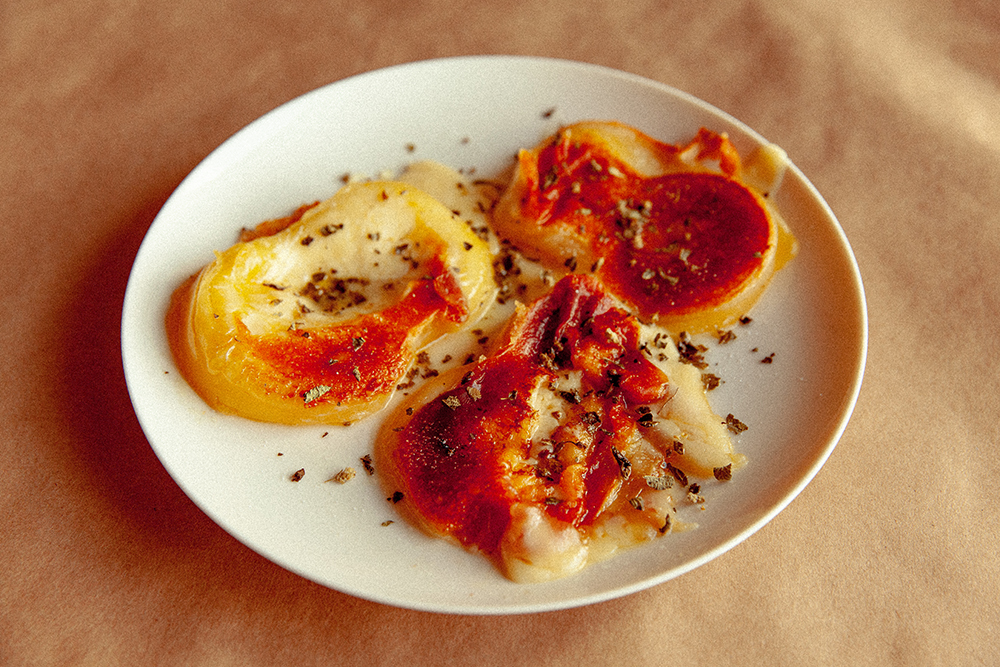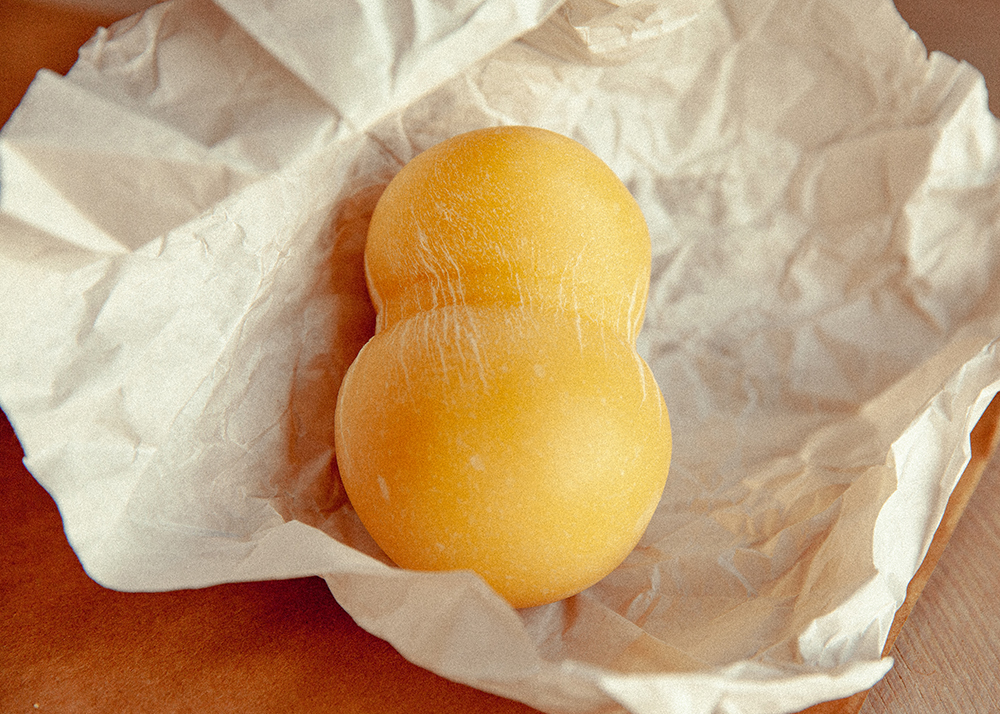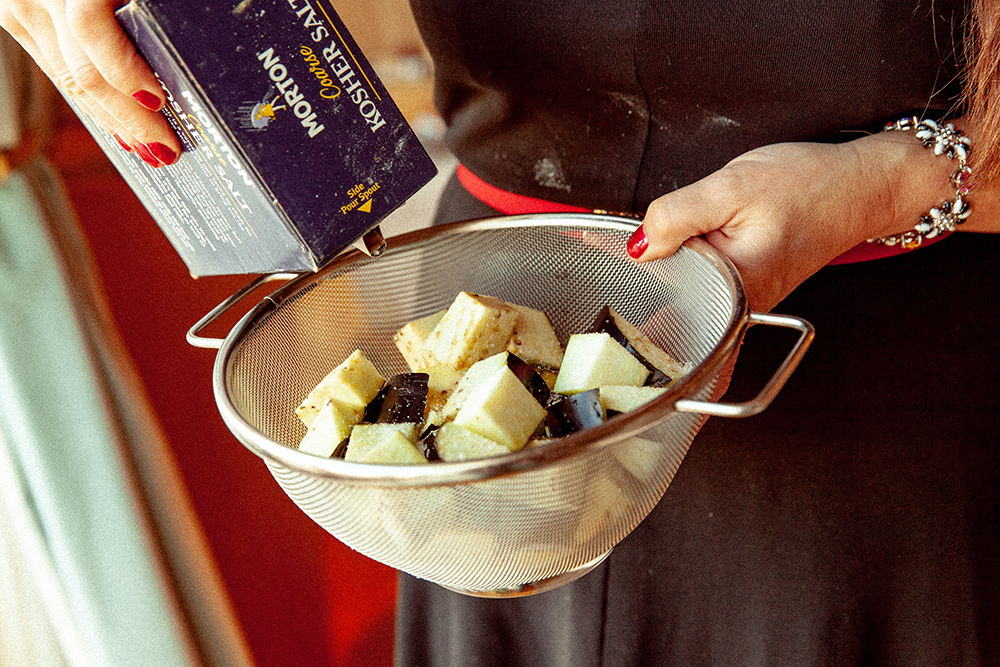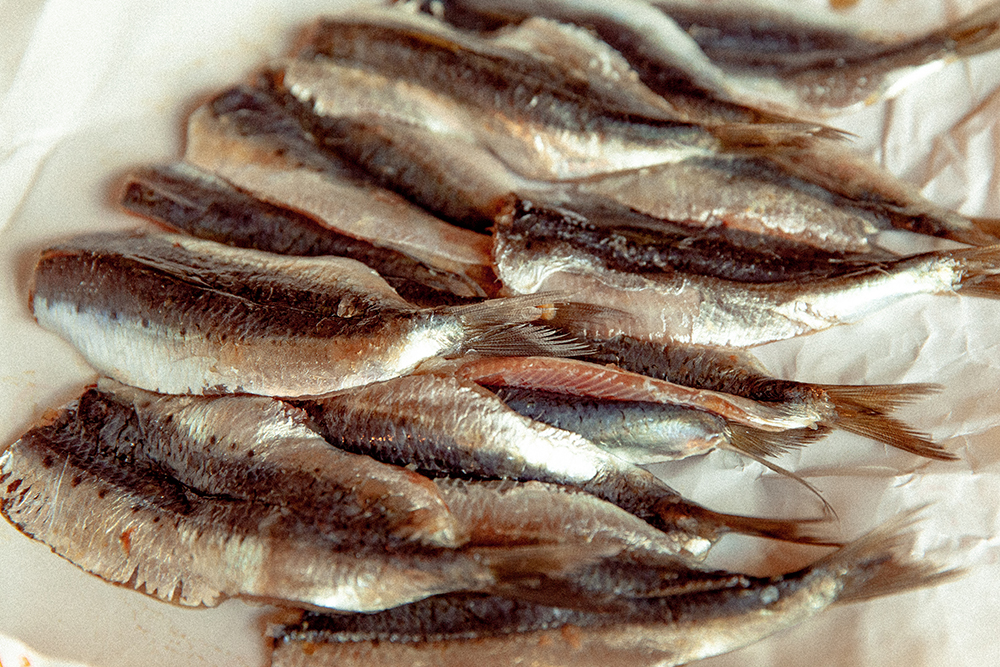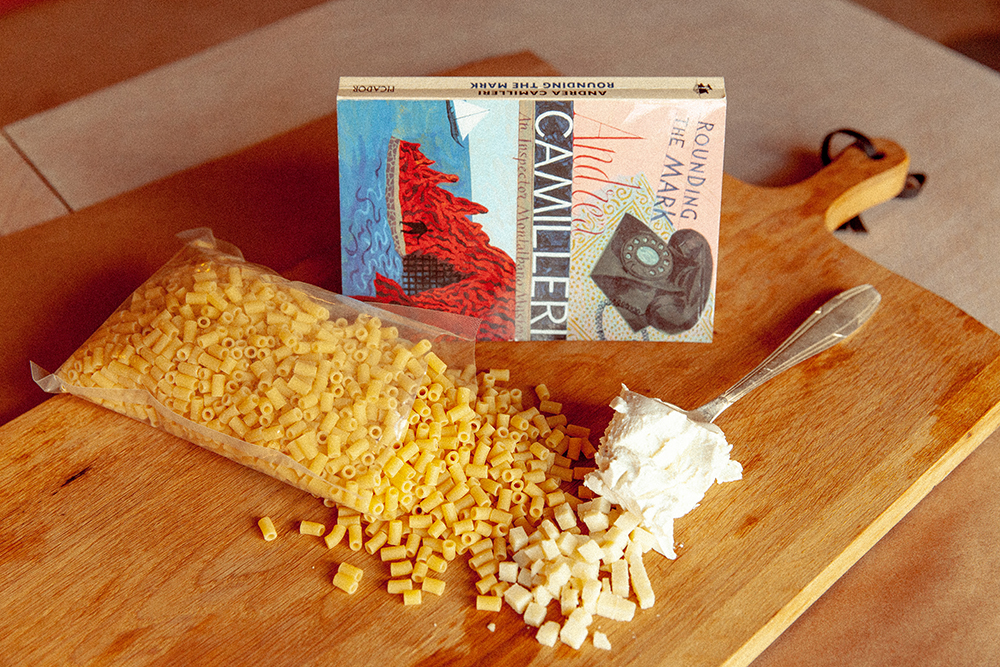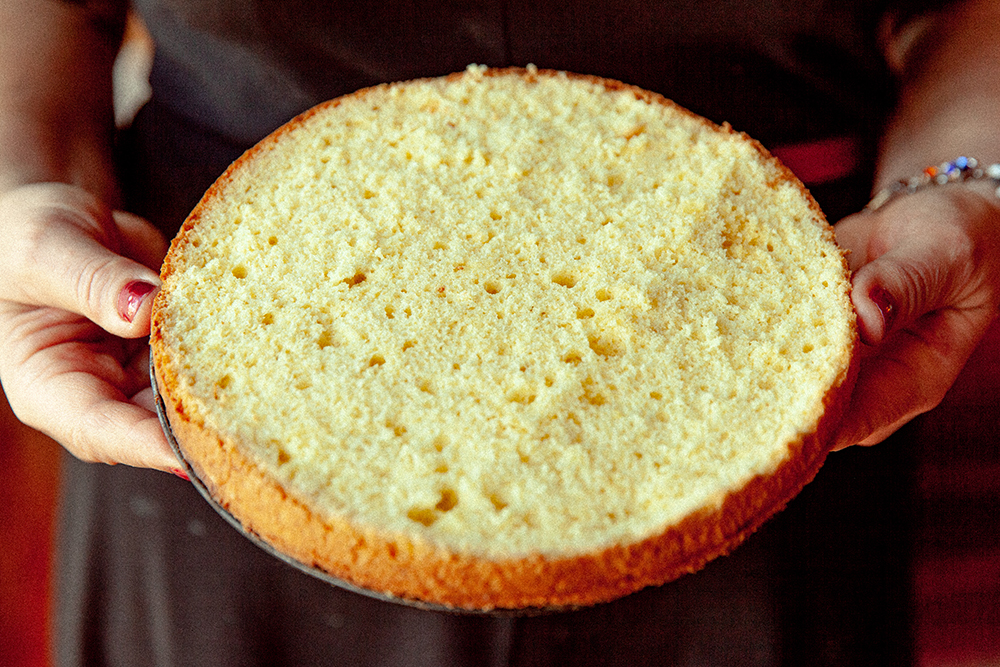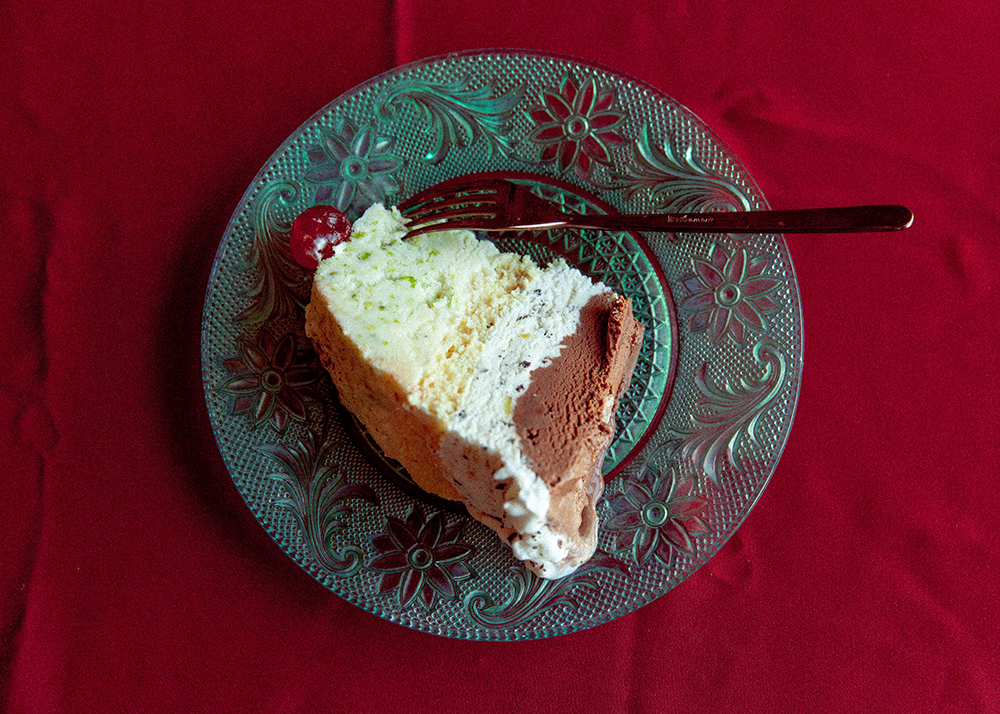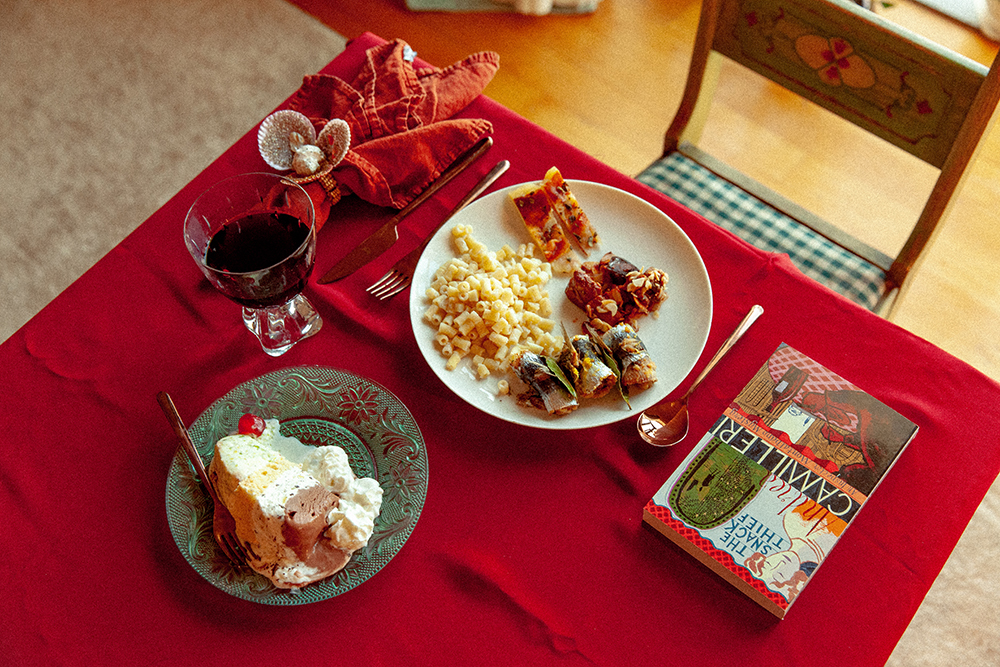Cooking with Andrea Camilleri
In Valerie Stivers’s Eat Your Words series, she cooks up recipes drawn from the works of various writers.
A police inspector wakes up in his beachfront apartment in Sicily and goes for a long swim, then to the office to confront his day of paperwork and complications: the corrupt officials, the jealous girlfriend, the frequent corpses. He has barely started before it’s time for lunch at the kind of restaurant he likes—one with no decor and the owner’s wife in the kitchen. The inspector is an aggressive, tightly wound man who does his job well. The pleasure that he takes in his food is an escape of a kind, an embrace of life by a person who regularly confronts death. The pleasure the reader takes in him is thanks to such signs of a deeper humanity, which add heft to the tales of murder in an exotic locale.
Many readers will already know that I am speaking of Inspector Montalbano, the creation of one of Italy’s best-loved contemporary authors, Andrea Camilleri (1925–2019). Many will also agree with me that at this point in the winter, the world of politics, and the ongoing COVID-19 nightmare, it’s time for some well-crafted, plot-driven escapism, and Camilleri’s books provide this. Conveniently, there are twenty-six of them, which means long stretches of joy. And that’s even before we start cooking from them.

In Excursion to Tindari, Montalbano opens his refrigerator to discover that his housekeeper has left “caponata! Fragrant, colorful, abundant, it filled an entire soup dish, enough for at least four people.” He consumes it with wine and bread for dinner. Photo: Erica MacLean.
Montalbano was a late-in-life success for Camilleri, a television writer trained for stage and film direction who began publishing novels only in his fifties and didn’t have a hit until a decade later. The first Montalbano book came out in 1994, when Camilleri was almost seventy, and the last one was published posthumously in 2020. The inspector has always been popular in Italy and is becoming increasingly popular in translation. A television series, in Italian with subtitles, is currently available on Amazon Prime, and a Montalbano tourism genre has sprung up in Sicily.
The books’ plots tend toward the lurid—mob bosses, pyramid schemes, kidnappings—but Camilleri prided himself on setting the action in the present day and making connections to the real world of Italian politics and bureaucracy. (One of the funniest running jokes is about the police department’s conversion to computers.) Montalbano’s character has depth: a neurotic mother who died young, a distant father who in old age owned a vineyard, a long-distance girlfriend whom he can live neither with nor without. (For me, part of the drama is continually hoping he’ll dump her—she can’t even cook!) But where the books really stand out is in their evocation of Camilleri’s native Sicily, an effect achieved, in many ways, through the food. It’s also worth mentioning that in the original Italian, the books are layered with humor employing the Sicilian dialect, a pleasure that readers in translation have to forgo.
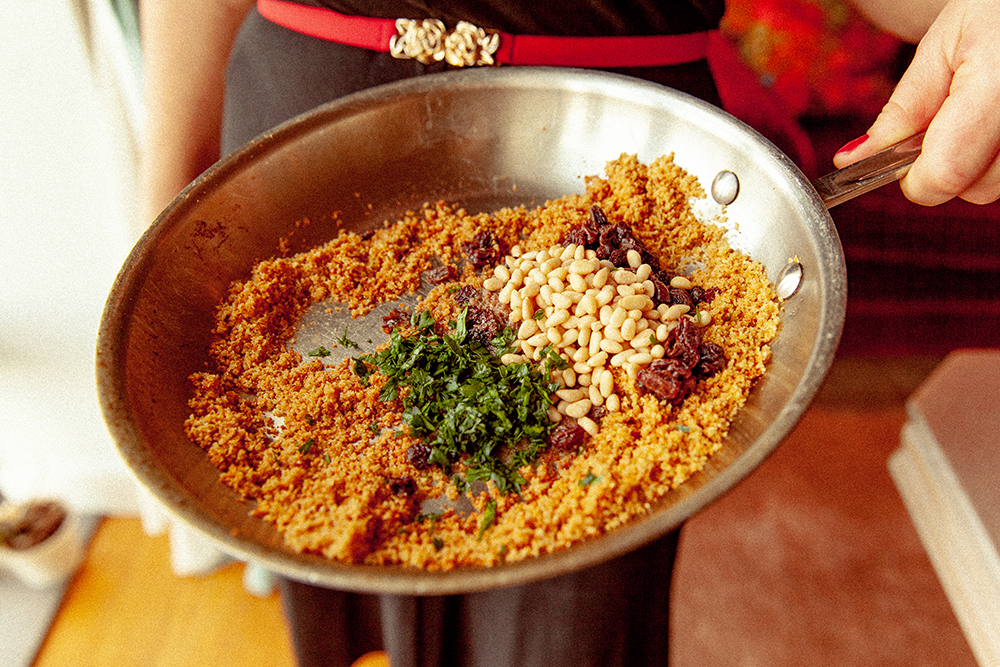
Rounding the Mark opens with Montalbano thrashing sleeplessly. He notes that for once it wasn’t because he had “bolted down too much octopus a strascinasali or sardines a beccafico the evening before.” Pictured here is the sardine filling. Photo: Erica MacLean.
The detective genre is foodie by nature—watching our hero eat dinner is an easy way to humanize a character about to perform inhuman feats—but Camilleri distinguishes himself by the extreme extent to which cuisine appears in his writing, and in the way his food shows us his native land. The Sicilian regional specialities on his pages are seemingly endless, and thus we learn that Sicily is a breadbasket, with an ancient, layered culture and deep traditions. The maritime bounty of Montalbano’s meals—at one point, he memorably eats a starter of grilled fish followed by a second course of grilled fish—demonstrates that Sicily is an island. We see the farming and animal husbandry traditions in the cheeses: ricotta, pecorino, a hanging bulb–shaped cheese called caciocavallo, and many more. And the wealth of desserts hints at the island’s history as a cosmopolitan hub of medieval Europe: cassata cake, gelato, marzipan pastry stuffed with pumpkin puree, cannoli, an extraordinary variety of named cookies.
The way Montalbano eats, too, tells us about his culture. Sicily, according to Mary Taylor Simeti’s cookbook Sicilian Food, is “a society in which the whole family eats all three meals at home.” Montalbano can’t do that—as a bachelor and a man of his time and place, he does not cook—but he has the next best thing: a housekeeper who cooks his dinners for him and, for his lunches, a favorite restaurant whose cuisine seems of a piece with the housekeeper’s. Not to say that the food is casual—on the contrary, the home cooking is composed. The order and formality of these meals, even at home, indicates a world of tradition, perhaps changing but still steeped in the past. Imagine any American these days sitting down in a restaurant—every day, during work!—to eat two courses of food, uninterrupted.
Simeti’s cookbook is her own “eccentric” historical look at food in Sicily. She includes copious quotations from source materials, starting in the ninth century B.C. with Homer—Odysseus, the first traveler, went to Sicily—and painting a picture of heat, sun, and culinary abundance. Simeti’s research also gives us a living glimpse of the island’s wealth and desirability, a status that led, as she says, to “centuries of foreign conquest and domestic oppression.” She concludes that the conquest and oppression have created an “insular” culture with “terrible density … daunting when it immobilizes the island in the face of its ills” but “fascinating and deeply satisfying when it informs … the actions and rituals of every day”—such as the cooking. Camilleri seems to see the same thing. Montalbano’s quasi-religious eating is the counterbalance to his days of trying to do good in a place where “things never budged, even when there was a storm on the horizon.”
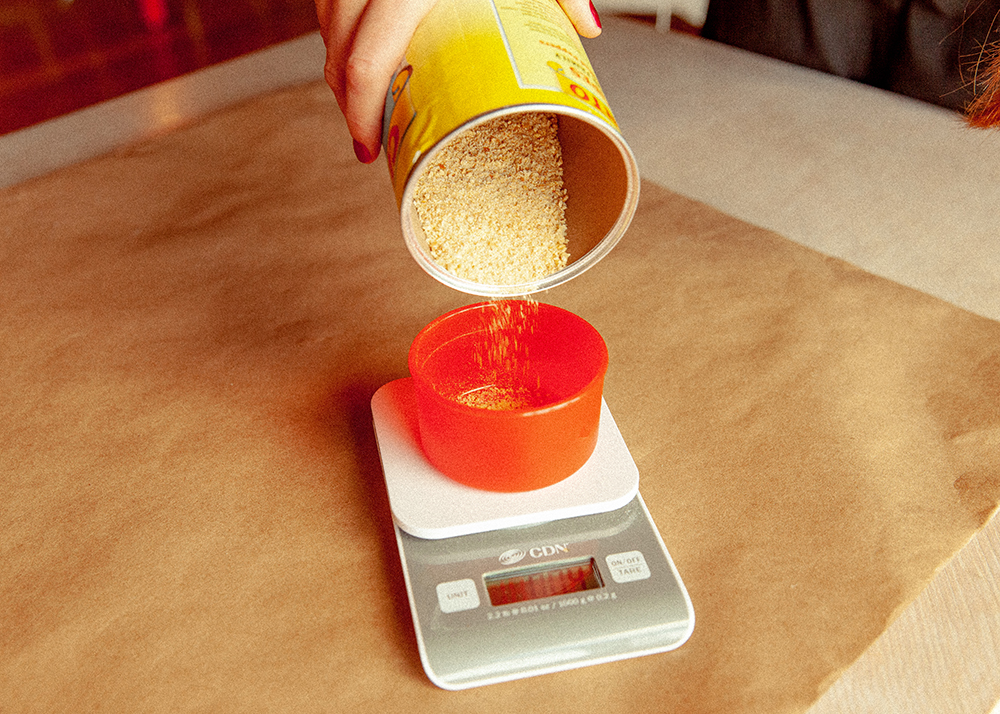
One of the many ways my Sicilian cooking sojourn was not a walk on the beach was that I had to convert all the cooking measurements. Photo: Erica MacLean.
As I read, I began to catalogue dishes by book and page number, and these lists soon sprawled over densely written pages that could provide inspiration for months or years of cooking. Almost everything Montalbano ate was unfamiliar to me, from his favorite snack of càlia e simenza (“a mixture of roasted chickpeas and salted pumpkin seeds,” eaten out of a paper cone) to the sardines a beccafico that cause him to wake with indigestion after having “bolted down” too many the night before. I already knew that caponata is an eggplant dish, but I wouldn’t have known it contains capers, green olives, and cocoa powder and is meant to be served cold. Tinnirùme are gently steamed zucchini blossoms. Cassata turns out to be an iconic Sicilian layer cake meticulously decorated with candied fruit. The frozen version appears at least twice in Camilleri’s oeuvre. Perhaps most tempting was the assortment of cookies: biscotti regina, mostaccioli, tetù, taralli. I could have made a menu of cookies alone.
With much hand-wringing and difficulty setting limitations, I decided to make sarde a beccafico, because I had to have a fish; ditalini with ricotta, pecorino, and black pepper (from a restaurant scene in the book Rounding the Mark), because I also had to have a pasta; “fragrant, colorful, abundant” caponata, to add a vegetable element; a “silversmith’s cheese” from Simeti’s cookbook that uses caciocavallo, one of Sicily’s intriguing cheeses; and lastly, as a challenge, the crazy layered tower of a frozen cassata. Simeti’s recipe suggested that I make the gelati myself.

The winemaker COS, whose red blend is seen here, has been making natural wine in Sicily long before it was cool to do so. Its vineyards are a short drive from the town Montalbano’s fictional town is based on. The white comes from a similar Sicilian coastal region, from a vineyard surrounded by a bird sanctuary. Photo: Erica MacLean.
To complement the meal, my spirits consultant, Hank Zona, suggested two Sicilian wines: a white Sicilia from the importer Mary Taylor and a red Cerasuolo di Vittoria Classico from COS. Zona describes the white as “just a really good Sicilian table wine of the kind they would have sat around drinking in Camilleri’s books.” It’s made from 100-percent Grillo grapes, which are native to Sicily, and has a bright, citrusy, food-friendly profile with a lot of salinity. Mary Taylor specializes in wines by small makers from distinct regions whose wines display the typical qualities of the grape. My red, from the winery COS, is a blend of two Sicilian grapes, Frappato and Nero d’Avola. The former is a grape that makes “lighter, more floral” red wine that’s good to serve chilled; the latter is “more full-bodied and tannic.” Blended, the two grapes have a cherrylike taste, a beautiful red color, and a lot of versatility. COS was started by three friends in 1980 and is now “the benchmark producer in the Vittoria appellation of Sicily,” Zona says, and is recognized as a pioneer of biodynamic winemaking in Italy. Sicilian wine in general is trendy, since high-quality winemaking is relatively new to the island and new makers are doing interesting things with local grapes.
Every one of my dishes brought Sicily a little closer, revealing something about the island’s food culture, provisions, or traditional cooking methods. The sarde a beccafico called for the sardines to be butterflied, despined, and then stuffed with a mixture of bread crumbs, pine nuts, and currants. The flavors remind me of the food of ancient Rome, and after a consultation with my fishmonger, I learned that the deboning is better left to the professionals because sardines have delicate flesh. This dish, intended to be served cold, improved in my refrigerator for several days after I made it. Unlike Montalbano, though, I found that a little sarde a beccafico goes a long way.
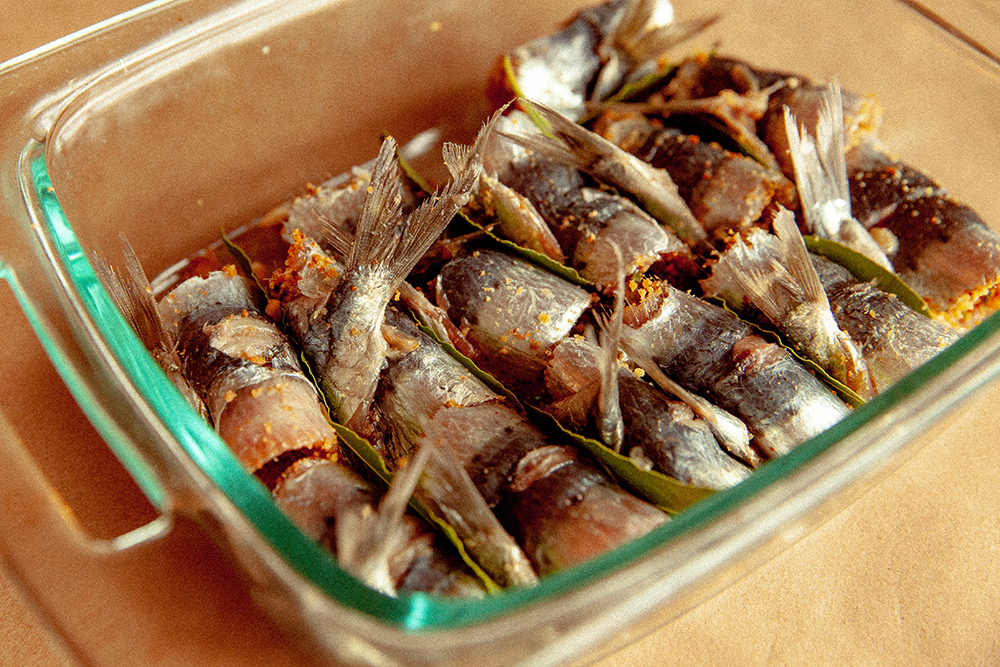
My cookbook explains the origins of sardines a beccafico: “The beccafico is a songbird that grows fat and sweet on a diet of figs, as fat and sweet as these sardines rolled about a filling of breadcrumbs, currants and pine nuts, and baked with orange juice and bay leaves.” Photo: Erica MacLean.
For my pasta, I was attempting to re-create a dish Montalbano eats in a restaurant with one of his femmes fatales, but I learned through internet research that this is such a humble preparation that there’s barely a recipe—you toss your cooked pasta with a little ricotta and pasta water, season it, and shave some pecorino cheese on top. Simeti, however, claims ricotta in Sicily is made from sheep’s milk, with the cow-milk variety “considered an inferior version.” I wanted to make some, but I discovered that to start it you need whey leftover from making … pecorino! The two cheeses in my dish were a natural pairing. Ditalini was hard to find—the selection of pasta shapes in the average grocery store is not what it used to be—but I tracked some down at Caputo’s Fine Foods, my local Italian grocery.
Caponata is another dish meant to be served cold, causing me to wonder if the “virtuous Sicilian housewives,” as Simeti calls them, responsible for all those home-cooked meals don’t have all kinds of cold, preprepared dishes up their sleeves, ready to set a quick table when the family returns home for lunch. The dish also calls for red sauce, which certainly would have been premade and canned once a year when the tomatoes were abundant. I bought mine at another legendary specialty shop, A.L.C. Italian Grocery, in Brooklyn.
Still yet a third Italian specialty source—Mia Famiglia, in Millburn, New Jersey—provided me with caciocavallo for my silversmith’s cheese (though actually what I bought was scamorza, a close cousin that also has the distinctive gourd shape achieved by being hung to dry). Caciocavallo, according to Simeti, is “the principal cow’s milk cheese of modern Sicily” and often serves as an accompaniment to pasta instead of Parmesan. The cheese melts slowly and thus is ideal for frying. This dish, seasoned with vinegar, was historically used as a substitute for meat or fish when neither were on hand. The “unusual combination” of cheese and vinegar, Simeti writes, was mentioned by the ancient Greek poet Archestratus as a Sicilian specialty. As a “cheese cutlet” for an easy dinner, I thought it was brilliant.

My cookbook quotes an eighteenth-century traveler’s note that in Sicily the frozen desserts were “so disguised in the shape of peaches, figs, oranges, nuts &c., that a person unaccustomed to ices might very easily have been taken in.” This was my best attempt. Photo: Erica MacLean.
My dessert, the frozen cassata, was an epic project requiring candied zucchini, a layer of sponge cake, a frozen Chantilly cream, three gelati (vanilla, chocolate, and pistachio), and a special metal mold of very specific dimensions that is impossible to purchase online in America. Fortunately, I am an old hand at candying a zucchini, and I have a set of metal bowls that turn out to be extremely useful vintage pudding molds (a score when you need to freeze a cassata or boil a dessert in the style of the British navy). One had just the dimensions I needed. I made the gelati myself because I was curious about Simeti’s recipe, which calls for cornstarch in the base, but unless you’re an expert at making ice cream, I think store-bought would be just as good or better. One benefit to making the gelato was that I was forced to shell and blanch my own pistachios; I was amazed by the increased brightness and freshness of flavor in comparison to the pre-hulled variety. For any dessert involving pistachios, this process is laborious but very worth it.
Did I succeed in opening a portal to Sicily and sitting at the table with Inspector Montalbano? Simeti writes that Sicilian food will never be the same elsewhere, since the local ingredients have a “peculiar intensity of flavor that the island’s merciless sun induces,” without which “almost any Sicilian recipe … will be immeasurably diminished.” Still, I was impressed by my plate’s combination of simplicity, practicality, frugality, and old-fashioned elegance, which seemed so different from the throw-anything-together way we eat today. Even without the smiting flavors of Sicily, the plate had balance, and the disparate items I’d chosen went together as if guided by the hand of an ancient tradition. And my Sicilian wines delivered the climate in a bottle. The meal wasn’t easy weeknight Italian, and it wasn’t even close to my style of home cooking, but it offered a philosophy I think I could learn from. Since a homemade dinner is now truly the best escape available, I was pleased.
Silversmith’s Cheese
Adapted from Sicilian Food, by Mary Taylor Simeti.
an ear of scamorza cheese, cut into slices 1/2 an inch thick
2 garlic cloves, crushed
1 tbs olive oil
1 tsp vinegar
2 tsp dried oregano
1/4 tsp sugar
Fry the garlic in oil in a medium-size heavy skillet over medium heat until browned. Discard the garlic, reserving the oil in the skillet. Add the slices of cheese and fry, about four minutes on the first side and two on the second, until brown and crispy. Remove carefully to a serving plate, and sprinkle with the vinegar, dried oregano, and sugar. Serve immediately.
Caponata
Adapted from Sicilian Food, by Mary Taylor Simeti.
1 1/4 lbs eggplant
salt
olive oil
half a medium-size onion, sliced
3 celery stalks, chopped and blanched for a minute in boiling water
20 pitted green olives, cut in half
2 tbs capers
3/4 cup tomato sauce
1/4 cup (or to taste) white wine vinegar
1 tbs sugar
1 tbs unsweetened cocoa
5 tbs toasted almond slivers
Cut the eggplant into one-inch cubes, sprinkle liberally with salt, and let drain for an hour. In the meantime, put the sliced onion in a medium-size skillet, and cover with water. Simmer on medium-low heat until the water has evaporated and the onion is beginning to brown. Resist the temptation to add salt at any point during this process; the other ingredients are very salty. Add a tablespoon of olive oil to the onions and fry briefly, then add the celery, olives, capers, tomato sauce, vinegar, sugar, and cocoa powder. Simmer on low for five minutes.
When the eggplant has drained, soak it in cold water to rinse off the salt, and squeeze dry with a kitchen towel. Heat a tablespoon of olive oil in a separate skillet, add the eggplant, and fry, stirring occasionally, until cooked through. Place on paper towels to drain.
Add the eggplant to the tomato mixture, stir to combine, and taste to adjust seasoning. Top with toasted almonds, and serve chilled or at room temperature. (Ideally, you would allow the caponata twenty-four hours in the refrigerator for the flavors to meld, but I did not wait that long.)
Sarde a Beccafico
Adapted from Sicilian Food, by Mary Taylor Simeti.
12 sardines (see instruction on preparation)
1/2 cup bread crumbs
3 tbs olive oil, divided
2 tbs pine nuts
2 tbs currants, plumped in hot water for five minutes
1 tbs minced parsley
4 anchovy fillets
12 fresh bay leaves
juice of a lemon
juice of an orange
2 tsp sugar
salt and pepper (to taste)
The sardines must be cleaned and prepared, heads removed, bodies butterflied, bones and spines removed. The tails stay on, and the fins can be cut off last, with scissors. My cookbook suggests that this can be done at home, but since the sardines’ flesh is delicate and the bones are small, this takes a sharp knife and considerable skill. I suggest asking the fishmonger for help. You can cut off the fins (but not the tails—they’re necessary for presentation!) at home with scissors if the fishmonger misses any.
Preheat the oven to 350, and lightly oil an eight-by-six glass baking dish.
Lay out the sardines, and season with salt and pepper.
In a small skillet, fry the bread crumbs in two tablespoons of olive oil, stirring regularly, until browned. Add the pine nuts, currants, and parsley, and season to taste. Take a sardine and, placing it skin side down, put a tablespoon of filling on it and roll it up toward the tail. Place it in the baking dish so the tail is sticking up in the air. Repeat this with the rest of the sardines, alternating them with bay leaves as if they were on a skewer and arranging them in neat rows so they have no room to unroll.
Sprinkle the sardines with lemon juice, orange juice, sugar, and a tablespoon of olive oil. Bake for twenty-five minutes. Serve cold.
Ditalini with Ricotta
2 cups ditalini pasta
1/2 cup sheep’s milk ricotta cheese
grated pecorino (to taste)
salt and freshly grated black pepper (to taste)
Cook the pasta al dente, according to the package instructions, reserving the pasta water when you are done.
Place the ricotta in a medium-size bowl, and add a cup of pasta water, stirring to make a creamy sauce. Add the sauce to the pasta, and stir to combine, adding additional pasta water if necessary to create a moist, creamy texture. Season with salt and freshly grated black pepper to taste, garnish with grated pecorino, and serve immediately.
Frozen Cassata
Adapted from Sicilian Food, by Mary Taylor Simeti.
Note 1: I believe that a perfectly acceptable variation on this recipe would be to use store-bought gelato or ice cream.
Note 2: If you are making your own gelato, start several days ahead of time. And even with store-bought gelato, you’ll need to make the pan di Spagna and compose the dessert the day before you plan to serve it, and allow it to harden overnight.
Note 3: You will need a rounded aluminum or tin mould that is 6 inches deep and 9 inches in diameter. Stainless steel, plastic, and glass do not work as they do not allow the dessert to freeze rapidly enough.
Overall requirements for the cassata:
pistachio gelato, about 2 cups
vanilla gelato, about 2 cups
chocolate gelato, about 2 cups
a three-quarter-inch layer of pan di Spagna (see recipe below)
an eight-inch springform pan
1/4 cup rum (not aged) or sweet liquor of your choice
candied zuccata (see recipe below)
frozen Chantilly cream (see recipe below)
additional whipped cream
specialty mold (see note 3, above)
toppings, such as chocolate shavings, candied fruit, nuts, or whatever you have on hand
For the gelati:
1 recipe crema rinforzata gelato base, plus mix-ins, to make the pistachio and chocolate gelati:
4 cups milk
4 tbs corn flour
1 1/2 cups sugar
1/2 cup very finely ground pistachios
3 tbs very finely ground almonds
3 1/2 ounces unsweetened chocolate
1/4 cup milk
1/2 recipe vanilla gelato:
1/2 cup heavy cream
half a vanilla pod
1 1/2 cups milk
3/4 cup sugar
2 tbs corn flour
an egg yolk
To make the chocolate and pistachio gelati:
Make the crema rinforzata. Heat three cups of milk to the boiling point. Remove from heat, and add the remaining cup of milk, in which you have dissolved the corn flour and sugar. Stir and return to heat. Bring once more to the boiling point, stirring constantly until thickened, then remove from heat. Separate into two equal portions.
To make the chocolate gelato, melt the chocolate in a quarter cup of milk over very low heat. Add to one portion of the crema, and stir to combine.
Allow both portions to cool, then chill in the refrigerator overnight.
Process in your ice cream maker according to instructions. To make the pistachio gelato, add the ground pistachios and almonds to the portion of plain crema, near the end of the processing time. Put both completed gelati in the freezer to chill overnight.
To make the vanilla gelato:
Heat the cream, the vanilla pod, and a cup of milk to the boiling point. Remove from heat, and add a half cup of milk, in which you have dissolved the corn flour and sugar. Stir, return to heat, and bring once more to the boiling point, stirring constantly until thickened. Cool, remove the vanilla pod, and beat in the egg yolk. Chill overnight, then process in your ice cream machine according to instructions. Put in the freezer to chill overnight.
For the pan di Spagna:
5 eggs at room temperature
1 cup sugar
3 tsp baking powder
1 cup self-raising flour
To make the pan di Spagna:
Preheat the oven to 350. Butter and flour an eight-inch springform pan.
Separate the eggs. In a stand mixer, whip the egg yolks until light and fluffy, and then continue beating, adding sugar slowly, until very pale and voluminous. Transfer the mixture to a large bowl. In a separate bowl, whisk together the flour and baking powder. In the stand mixer, whip the egg whites until soft peaks form. Combine the whites with the yolk mixture, folding gently to combine, then sift the flour mixture over slowly, and fold to combine. Pour into the prepared pan, and bake for twenty-five to thirty minutes, until the sponge pulls away from the sides of the tin and a tester comes out clean. Let cool, and cut an even three-quarter-inch layer from the center of the cake. Reserve the rest in the freezer for other uses.
To make the zucatta (candied zucchini):
1 lb zucchini
sugar
water
1/2 tsp rose water
Peel the zucchini, cut it in half lengthwise, and slice into three-inch pieces. Cook in abundant boiling water until tender. Drain; place, seeds down, on a tray; and dry in the sun for two hours (or in your oven with the light on).
Remove the seeds, cut into very small cubes, and weigh. Put into a heavy saucepan with equal weights of sugar and water. Cook over a low flame, stirring frequently, and continue to cook until the preserves are thick. Add the rosewater at the end.
For the frozen Chantilly cream:
4 room-temperature egg whites
3/4 cup sugar
2 cups heavy cream
2 oz unsweetened chocolate, finely shaved
4 tbs diced zucatta
To make the frozen Chantilly cream, whip the egg whites until stiff, incorporating half a cup of sugar at the end. Whip the cream and a quarter cup of sugar until soft peaks form. Fold the cream into the beaten egg whites, and put the mixture in the freezer. Wait until the mixture is beginning to stiffen before folding in the zucatta and chocolate shavings (if you don’t wait, they’ll all fall to the bottom). Freeze until ready to use.
To assemble the cassata:
Cut out a disk of parchment paper the same diameter as the mold, and place it in the bottom. You must assemble the cassata layer by layer, allowing time both for each kind of gelato to soften enough that it can be spread and for it to harden again in the freezer; otherwise, it will melt into a mess. The proper order is as follows: pistachio at the bottom, then vanilla, then the pan di Spagna sprinkled with the rum, followed by the Chantilly cream and, on top, the chocolate gelato.
Freeze for five or six hours. Turn the cassata out onto a cake platter, remove the paper, and decorate with chocolate shavings, candied fruit, nuts, and additional whipped cream.
Valerie Stivers is a writer based in New York. Read earlier installments of Eat Your Words.


